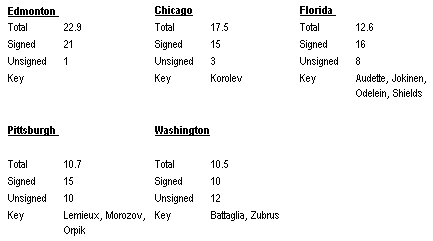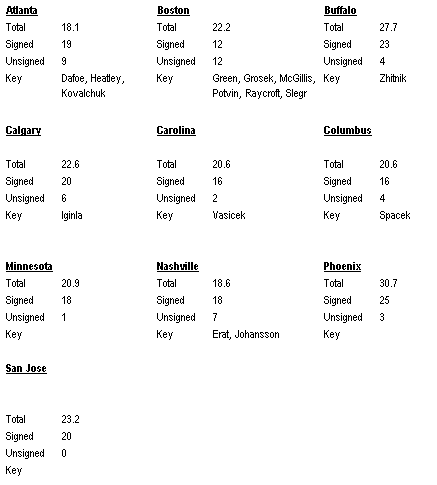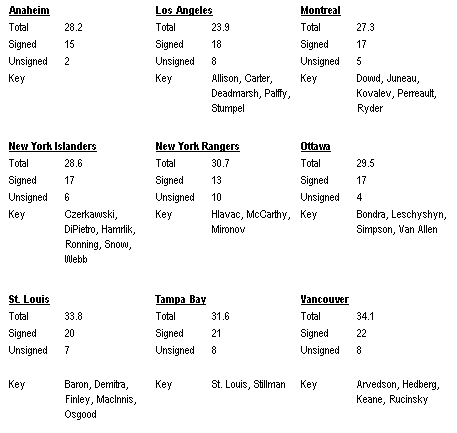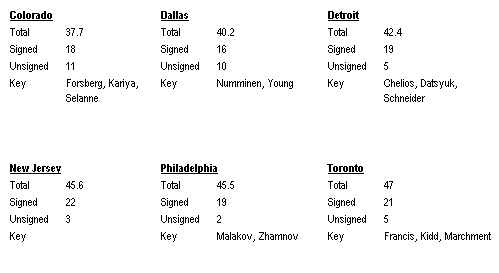|
The Return of NHL Hockey?
Looking at the Rumoured New World
D'Arcy McGrath
June 9th, 2005
Hands up �
Who's had just about enough with the CBA, money and the game of hockey being broken? Tired of the non-quotes, the jabs at the sport and the moronic quips by players to far removed from reality to deserve a spot at the podium?
Yeah, me too.
That's why it's time to return to a good old fashioned hockey article, you remember those � games stories, game days, Charlton's insightful opines on all matters hockey, or a kick at the numbers by yours truly.
All recent discussion point toward a break in labour talks and perhaps an actual pact agreed to in the not so distant future.
When that happens the gun will fire on the most intriguing and fretful hockey off season in National Hockey League history.
Players will be signed, waived, retired, traded for and bought out in order to move 30 23 man NHL rosters into place in what could be only 60 days.
A great time for the token hockey fan, but a serious make or break team building mad dash for the circuit's 30 general managers with more on the line for club rosters than at any other time for any of these gentlemen.
Lets take a look at some of the issues.
The Roll Back
Once you offer something in a negotiation you're pretty much stuck with it.
The NHLPA made a huge splash in December when they offered to unilaterally roll every player's salary back by 24% without offering any real controls to keep said salaries down.
Was this done to put pressure on the owners in the hopes of keeping an open ended system? If that was the motivation, the PR stunt failed, the system will be closed, but the roll back stuck.
The roll back has made an appearance in every single NHL offer since, and you can quite likely count on it in the finished deal when it rears its pretty head.
This has a huge significance to every chapter in the league, but represents a true �start over� point for small markets that are used to losing their high priced talent on their second or third
contracts.
Last summer the Flames traded Denis Gauthier and Oleg Saprykin to Phoenix for Daymond Langkow. The deal stands on its own in terms of player talent, but it's quite likely that part of the reason for the deal was the fact that the Flames were shopping Gauthier and his 1.6 million dollar contract.
Gauthier is a solid defenceman, but on a Flames roster that could boast as many as nine NHL ready rearguards, Mr. Gauthier just wasn't a million dollars better than the clubs other options for a 5th or 6th defenceman.
A roll back helps to re-set the clock for this type of player.
The roll back should also help the Flames in negotiations with captain Jarome Iginla. True he isn't signed and therefore won't be rolled back with other players, but he and his agent, Don Meehan, will find that his comparables like Boston's Joe Thornton (6.75 for 2004/5 before a roll back) will have been.
From the union's perspective it's hard to gauge their lean when it comes to the inclusion of the roll back. Giving up salary is never an aim of an association, but a rolled back group would experience less instability of player movement than if each player kept his salary at the current level.
Years of Service or Calendar
This is the absolute water shed for the off season and the temperature reading on the transaction wire for this summer.
It was assumed that every signed NHL player lost a year off his existing contract when the season was canceled by Gary Bettman on February 16th.
This was the likely the case, but it's far from assured and could be very much on the table when the final details of the CBA are pounded out.
The answer will have a huge impact on roster movement in the off season.
Take the Calgary Flames for example.
If the 2004/5 contract year is simply applied forward to 2005/6 the Western Conference champions will have a fully signed NHL roster missing only Jarome Iginla, sitting at roughly 31 million bucks (almost 23.5 million rolled back). Iginla's inclusion would put the team in a well spent 38-39 million dollar range (29 million rolled back), leaving very little spending room and certainly no roster space.
If, however, the year is burned up on each of these players contracts the Flames would be in a very different scenario. In this case the Flames would have only 11 players under contract for a spent total of roughly 14 million dollars, or 10.5 million in a rolled back situation.
The optionality gets greater when you consider that three of these 11 players are somewhat fringe in nature, leaving only eight roster spots sewn up by regular NHL players (Lydman, Regehr, Wiemer, Yelle, Nilson, Simon, Donovan and perhaps Dion Phaneuf. Byron Ritchie, Mike Commodore and Steve Montador are signed but have far from guaranteed themselves spots).
If that year of duty is burned up with a lockout the Flames could be a completely remade team when they watch that banner being raised at the Saddledome. They should have over 20 million bucks to spend in adding about 16 players to their roster.
If the year stands for the 2005/6 season the Flames will have a roster pretty much done, with little wiggle room to add salary, setting the table for some Sutter wheeling and dealing.
Around the League
If the rumoured deal hits the mark, that is a capped system with an underlying luxury tax system with triggers of say 36.0 million and 29.0 million respectively, we will see full out chaos in the league, especially if last year's service isn't wiped off of contracts.
For fun I had a look around the league and assigned each club to four categories; Advantaged, the Good, the Bad, and the Ugly.
All numbers were supplied by NHLPA.com, and rolled back by 24%. This provides a very good indication of each club's situation, but doesn't reflect nuances that only each market could pin down for certainty.
Take the Flames for example.
The Flames, as per the NHLPA site, will have a 22.6 million dollar payroll with 22 players signed, and four players unsigned. The only key player to be signed is of course, Jarome Iginla. What this doesn't tell you is that included in the list of signed players are the salaries for players like Lynn Loyns and Anders Eriksson, two players that are in tough to make any form of a Calgary roster, and doesn't include the signed Dion Phaneuf who could crack the squad.
Therefore this analysis comes with a caveat that there is clearly some maneouvering within the numbers.
The Advantaged
There are five teams that stick out as having the best situations heading into an off season with the assumed economic system in play; the Oilers, Hawks, Panthers, Penguins and Capitals.

Each of these teams have a healthy combination of low committed payrolls, or very committed payrolls with nobody of significance left to sign and some space below the luxury tax kick in point.
The Capitals and Penguins have 19 million bucks a piece to blow in signing players without too many of their own left to ink. They should have a field day adding bodies from around the league and will take the ice with completely remade rosters.
The Oilers have their whole team signed for just under 23 million bucks and can add an impact player to replace Petr Nedved and still come in under the luxury tax hurdle.
The Panthers have lots of space and only a few key guys left to sign off their own charts.
The Good
A larger band of teams fall into the �Good� category, which can be loosely defined as teams that aren't positioned to take advantage of teams, but that won't have any tough decisions to make with their own rosters.

The above teams are all in pretty good shape to arrive at a 29-30 million payroll range without causing any carnage to their rosters. Teams like Boston, Buffalo, Calgary, Carolina, Columbus, Phoenix and San Jose are pretty much set, while clubs like Minnesota and Nashville have the salary space to fill out their teams.
Atlanta is in a unique position given two of their star players are unsigned.
The Bad
The �Bad� represents a large group of teams in some peril, but not to the fire sale stage as the �Ugly� group.
Here we find clubs that are over the luxury tax hurdle without complete rosters signed, meaning some tough decisions will have to be made in order to ice a competitive club.
Some teams will logically choose to be above the 29 million dollar tax hurdle and will have more wiggle room, but others like three Canadian clubs below (Montreal, Ottawa and Vancouver), may feel the pinch to get down to a manageable number.

The Ducks, Habs, Islanders, Rangers and Senators all need to add 5-7 players and already sit close to 29 million per season.
Tampa, St. Louis and Vancouver are approaching the hard cap point with full rosters but may need to make moves in order to avoid a heavy tax burdern.
The Kings are a very unique club in that they have 18 signed, and sit 5 million below the rumoured tax hurdle, but have several marquee names on the sidelines without contracts � though that number includes the assumed departed Jason Allison, and the assumed retired Adam Deadmarsh.
The Ugly
The group that fans will want to keep the keenest eye on in the coming months are the former big spending clubs that now find themselves in the �Ugly� category with a new CBA.
Small market fans around the league will take great joy in watching this daily soap opera unwind as these teams buy out players or make money trades in a complete reverse fashion to what fans in their markets are accustomed.
No longer buying, selling baby selling.
 All six clubs above already sit beyond the rumoured cap level and many still have some key players to sign.
All six clubs above already sit beyond the rumoured cap level and many still have some key players to sign.
Each of these teams will be in tough to retain any of their current unrestricted free agents, though you'd have to assume Colorado will do everything they can to sign Peter Forsberg, and that Detroit won't let Pavel Datsyuk get away.
From there it's buyout central with the Avalanche likely forced to pay their way out of Konowalchuk and Damphousse's contracts, and perhaps deal another big ticket player like Alex Tanguay Milan Hejduk, or Adam Foote.
Dallas will likely buy out Pierre Turgeon, and try to deal a player like Jason Arnott.
Detroit will have some tough decisions to make if Steve Yzerman wants to play another season and Nik Lidstrom wishes to play another season in North America. Look for a guy like Robert Lang to be jettisoned to keep a player like Datsyuk in the fold.
If Scott Stevens can play the Devils will have almost 16 million bucks tied up in three players, and will surely have to move a couple players like Jeff Friesen, Brian Rafalski and Jan Hridina.
They Flyers will be burdened by that fat John Leclair contract and may wish they didn't add players like Sean Burke, Tony Amonte and Sammi Kapanen last year. Very few of their high ticket players come with much marketability.
The Leafs sit at the top of the Ugly list with their top eight paid players almost tossing them over the cap limit and players with little demand like Belfour, Mogilny and Nolan at the top crushing their ability to make roster moves. The Leafs may have to buy out four or five players to get down under the cap, or trade players that teams may want like Brian Leetch, Tomas Kaberle, or Brian McCabe.
Fire Up Those Fax Machines
Losing a hockey season in Canada is a very painful exercise, what good is winter without our annual pastime. The season just doesn't captivate with slush, cold temperatures and CBA updates.
However, the pain in this case has certainly resulted in some serious gain for hockey fans of smaller markets, a 365 day bandaid yank that will give birth to a whole new era for people that have seen star after star leave for money in the past decade.
No more Save Our Flames campaigns.
No more home grown players heading off to greener (money) pastures.
A new era is upon us, open the door and let it in!

|
|